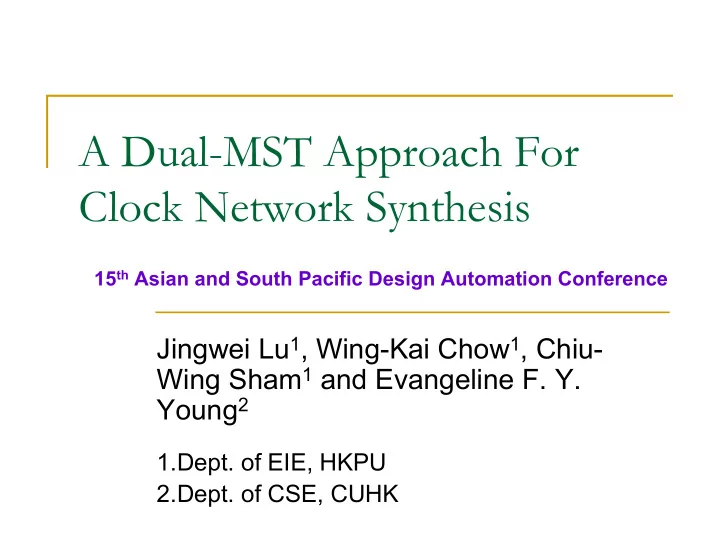

A Dual-MST Approach For Clock Network Synthesis 15 th Asian and South Pacific Design Automation Conference Jingwei Lu 1 , Wing-Kai Chow 1 , Chiu- Wing Sham 1 and Evangeline F. Y. Young 2 1.Dept. of EIE, HKPU 2.Dept. of CSE, CUHK
Presentation Overview � Introduction � Background � Methodology � Experimental result � Conclusion ASP-DAC 2010
Introduction � Distribution of clock network � PVT (process, voltage, temperature) variation-tolerant � Previous works � Equidistant clock routing [M. A. B. Jackson et al. DAC’1990] � Exact zero skew [R.-S. Tsay, ICCAD’1991] � Cross links insertion [A. Rajaram et al. DAC’2004] ASP-DAC 2010
Background � ISPD2009 Clock Network Synthesis Contest [Sze et al., ISPD ’ 2009] � Slew rate constraint � Less than 100ps along the whole network � Power consumption constraint � Use total capacitance as a representation � Blockage for buffer insertion � Clock Skew and Latency Range � The range of skew values under two voltage settings (1.0 V and 1.1 V) ASP-DAC 2010
Synthesizer Overview � A bottom-up approach of clock tree construction � DME [Chao et al., DAC’1992] is applied � Look-up table is pre-built for slew rate reference � Two approaches of CTS are developed � DMST Elmore RC model � Zero skew synthesizer � � DMSTSS An advancement of DMST � SPICE simulation for delay estimation � ASP-DAC 2010
Methodology Overview � Level-divided tapping point relocation � Iterative removing and rebuilding of upper tree sections � A dual-MST topology construction � Dynamic buffer sizing � Recursive nodes merging and buffer insertion � Improved maze router for blockage handling ASP-DAC 2010
DMST Overview nodes at level i go to level i+1 maze routing when handling blockage ASP-DAC 2010
DMSTSS Overview nodes at level i go to level i+1 ASP-DAC 2010
Clock Tree Construction SPICE simulation finished Tapping point relocation rebuilding removing Tapping point relocation The orange-shadowed removing rebuilding section means fixed Tapping point relocation DMST ASP-DAC 2010
Dual-MST dual-MST finished matching finished build dual-MST matching pair 3 matching pair 1 matching pair 2 matching pair 4 ASP-DAC 2010
Topology Comparison CLUSTERING dual-MST ASP-DAC 2010
Performance Comparison dual- MST Clusteri ng MMM* It is a modified version of original MMM with a CLR SKEW WL CAP CPU bottom-up procedure ASP-DAC 2010
Buffer Sizing Bigger buffer size on source common paths sinks ASP-DAC 2010
Buffer Insertion Direct upstream driving Buffer shifted for slew Balancing point with Next recursion constraint one buffer insertion ASP-DAC 2010
Blockage Full detoured wire Buffer insertion along the pre-determined path connection ASP-DAC 2010
Blockage Concurrent buffer insertion ASP-DAC 2010
Comparison Less resources cost full detour our approach ASP-DAC 2010
ISPD2009 Circuits Table CUICIRTS SINK # BLOCKAGE (%) CAPACITANCE (fF) 11 121 0% 118000 12 117 0% 110000 21 117 0% 125000 22 91 0% 80000 31 273 24.38% 250000 32 190 34.26% 190000 27.68% 33 209 195000 38.67% 34 157 160000 35 193 33.22% 185000 37.69% nb1 330 42000 nb2 440 63.88% 88000 23.62% AVG 203.5 140273 ASP-DAC 2010
CLR & SKEW DMSTSS DMST T4 T6 BEST CIRCUIT CLR SKEW CLR SKEW CLR SKEW CLR SKEW CLR SKEW 11 12.2 6.5 20.5 15.6 26.7 4.7 32.3 5.2 22.3 6.4 12 10.9 7.0 22.2 18.6 25.7 4.8 32.2 5.9 22.2 5.4 21 12.1 6.7 22.0 17.3 30.5 5.3 34.3 6.1 19.6 3.2 22 9.9 4.3 17.1 11.9 24.5 3.4 30.4 7.1 16.4 3.0 31 13.4 10.1 39.1 36.7 45.1 7.6 51.3 10.9 45.1 7.6 32 11.5 8.8 27.7 24.3 36.9 5.3 40.3 6.4 18.4 7.7 nb1 13.8 7.9 26.1 17.1 NA NA 19.8 7.2 19.8 7.2 AVG 12.0 7.3 25.0 20.2 31.6 5.2 34.4 7.0 23.4 5.8 33 13.4 6.2 22 23.1 NA NA NA NA NA NA 34 11.3 11.1 26.2 18.8 NA NA NA NA NA NA 35 13.1 7.8 20.2 21.2 NA NA NA NA NA NA nb2 13.1 8.7 35.4 30.1 NA NA NA NA NA NA ASP-DAC 2010
CAPACITANCE & CPU DMSTSS DMST T4 T6 BEST CAP CPU CAP CPU CAP CPU CAP CPU CAP CPU CIRCUIT 11 79.3 180 79.6 0.3 85.5 14764 73.9 3892 89.9 23358 12 89.3 213 90.3 0.3 84.7 13934 73.5 3944 87.9 14992 21 83.2 210 83.6 0.3 80.8 14978 74.3 4587 86.7 26420 22 79.4 113 79.4 0.3 81.8 7189 70.0 2005 85.0 9432 31 83.4 777 84.6 1.3 73.5 40088 81.5 17333 73.5 40088 32 82.4 420 82.6 0.4 80.1 3566 77.4 10599 89.9 2888 nb1 82.0 82 84.3 0.6 NA NA 63.1 477 63.1 477 AVG 82.7 285 83.5 0.5 81.1 15753 73.4 6119 82.3 16807 33 83.6 483 83 0.4 NA NA NA NA NA NA 34 85.7 354 85.7 0.4 NA NA NA NA NA NA 35 85.0 453 84.9 1.9 NA NA NA NA NA NA nb2 87.9 202 89 1.6 NA NA NA NA NA NA ASP-DAC 2010
Result Comparison DMSTSS DMST T4 T6 BEST CLR CPU ASP-DAC 2010
Conclusion � We have proposed two approaches for clock tree synthesis, DMST and DMSTSS � CLR (clock latency range) is greatly reduced � CPU time is greatly reduced � Neither slew rate violation nor blockage violation is met � Link insertion can be applied for further improvement ASP-DAC 2010
Q&A ASP-DAC 2010
Recommend
More recommend